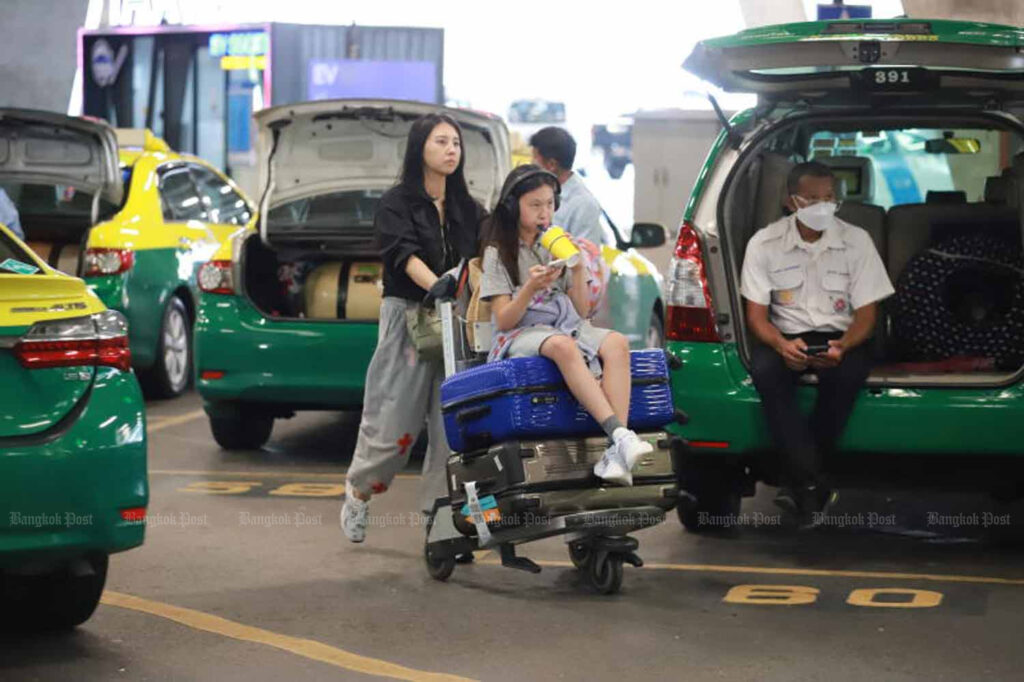BANGKOK – Thailand in 2025 still offers standout value. You can eat well, sleep comfortably, and explore famous sights without draining your savings. Most budget travellers spend about $35 to $50 per day for basics in November 2025, and careful planning keeps you on the low end of that range.
This guide gives you real daily costs, a simple budget breakdown, money-saving hacks that actually work, and a 7-day sample budget you can copy. Expect real numbers, clear examples, and tips you can use to plan fast.
How Much Does a Thailand Trip Cost Per Day in 2025?
Quick answer for budget travellers plan for $35 to $50 per day. That covers a basic room, street food, local transport, water, and a few activities.
- Islands and peak season can raise prices by 30 to 50 percent.
- Northern cities like Chiang Mai are usually cheaper.
- International flights are extra. Economy round-trip tickets often run $600 to $900, based on origin and season.
Shoestring Budget: $30–35 per day, what you get
A bare-bones day is simple but doable.
- Bed: dorm or very basic fan room, about $5 to $10
- Food: street meals, about $1.50 to $3 each, three times a day
- Transport: short rides on buses or songthaews, usually under $1 to $2
- Activities: free temples, markets, parks, and viewpoints
- Water: refill stations keep costs low
Trade-offs: slower travel, limited nightlife, simple rooms, and fewer paid tours. You will stretch your days but save a lot.
Backpacker Comfort: $35–50 per day for flexibility
This is the sweet spot for most travellers.
- Bed: private budget room, about $10 to $20
- Food: mix of street food and cheap cafes, $2 to $6 per meal
- Transport: a few Grab rides for convenience when tired or late
- Activities: a paid activity here and there, $10 to $30
This range lets you stay flexible, book last-minute deals, and treat yourself sometimes.
Mid-Range on a Budget: $60–90 per day
Pay a bit more for comfort and time savings.
- Bed: nicer private rooms or small hotels, $25 to $45
- Food: more sit-down meals and coffee stops
- Transport: domestic flights booked early for $30 to $50
- Activities: a couple of paid tours, $20 to $50 each
Good for pairs or anyone who values comfort and shorter travel times while still watching costs.
Location and Season Matter: Bangkok, Chiang Mai, Phuket
- Chiang Mai is often the cheapest. Rooms and food are lower priced.
- Bangkok is moderate, with options at all price points and great transit.
- Phuket, Koh Samui, and other islands cost more for rooms, tours, and transport.
- Shoulder or low season usually brings cheaper stays and flights. Peak months raise prices, especially on islands.
If you travel in 2025, keep an eye on new events and tourism plans. They can impact demand and pricing in big cities. For context on what is rolling out, see ATTA and TCEB’s 2025 tourism proposals.
Thailand Travel Budget Breakdown: Where Your Money Goes
Here is a quick view of typical daily ranges in 2025. Adjust for city and month.
| Category | Budget/Backpacker (USD) | Mid-Range on a Budget (USD) |
|---|---|---|
| Accommodation | $8–$15 | $25–$50 |
| Food and drinks | $8–$15 | $15–$25 |
| Transport (local) | $3–$8 | $10–$20 |
| Activities | $5–$15 | $15–$40 |
| Extras | $2–$6 | $5–$10 |
- Bangkok and Phuket sit at the higher end of each range.
- Chiang Mai and northern towns sit at the lower end.
- Islands can exceed the high end during peak season.
Accommodation Costs: Hostels, Guesthouses, Budget Hotels
- Dorms or basic private rooms run $5 to $15 per night in many places.
- On popular islands, expect higher rates and faster sell-outs.
- Private rooms with AC near hotspots cost more, even in cities.
Quick tips:
- Book early for islands and peak months.
- Check reviews for cleanliness and AC performance.
- Look for freebies like breakfast, water refill, or laundry.
Food and Drinks: Real Prices for Meals and Snacks
- Street food favourites like pad kra pao, noodles, or fried rice often cost $1.50 to $3.
- Simple sit-down meals and cafes cost more, often $3 to $6.
- Fruit, snacks, and fresh juices are cheap at markets.
- Alcohol raises daily costs quickly. A few beers can match your food budget.
Save more:
- Refill water at stations instead of buying bottles.
- Try market stalls for variety and value.
- Skip imported snacks and drinks that add up.
Getting Around: Buses, Trains, Ferries, Grab, Flights
- Local buses and songthaews are often under $1 to $2 per ride.
- Short Grab rides cost more but stay reasonable in cities.
- Domestic flights across regions can be $30 to $50 when booked early.
- Ferries to islands add up. Compare round-trip passes or combos.
Scooters help on short distances in smaller towns. Rent only if you hold a valid license and insurance. Wear a helmet and follow local laws. Fines and accidents cost more than a few Grab rides.
Activities and Tours: What to Budget
Free and low-cost:
- Temples, city parks, street markets, urban walks, and beach days
Paid options:
- Cooking classes, day trips, and island tours, often $10 to $50 based on length and inclusions
Compare group size, transport, lunch, gear, and entry fees. Cheaper is not always better if it cuts safety or comfort.
Trip Extras: Visas, SIM Cards, Insurance, and ATM Fees
- Visas: Some nationalities enter visa-free. Others pay about $30 to $50.
- SIM card: Data packages run about $10 to $15 for one to two weeks.
- Insurance: Budget $5 to $10 per day for solid coverage.
- ATMs: Many charge a fixed fee per withdrawal. Take out larger amounts less often to reduce fees.
Money-Saving Hacks in Thailand That Actually Work
These are simple, effective, and suited to 2025 travel patterns.
Eat Local and Use Markets for Big Savings
- Make street food your default. Add fruit and snacks from markets.
- Carry a refillable bottle and use water stations.
- Try setting lunch specials. Avoid imported snacks and premium drinks.
Move Smart: Public Transport, Shared Rides, and Scooters
- Walk short distances. Use buses or songthaews for routine trips.
- Use Grab when it is late, raining, or you have bags.
- Rent a scooter only when it saves time and money. Bring your license, wear a helmet, and keep your rental papers.
Travel in Shoulder Season for Cheaper Stays and Flights
- May to October usually delivers lower room rates and fewer crowds.
- Expect some rain, but trips still run in most regions.
- Book flexible stays. Watch weather patterns by region before paying in full.
Book Smart and Negotiate When It Fits
- Book popular routes and tours early online for better prices.
- For local services and markets, ask politely about discounts.
- Compare a few quotes. Check what is included, like gear, lunch, or park fees.
- Avoid add-ons you do not need.
Digital Money Tips: Local SIM, Cards, and ATMs
- Get a local SIM to use maps, chat, and ride-hailing apps cheaply.
- Use a travel card with low foreign fees if you have one.
- Withdraw cash less often to avoid repeated ATM fees.
- Keep small bills for markets, tips, and local transport.
One-Week Thailand Budget Example and Easy Cost Calculator
Use this as a starting point. Adjust for your dates and cities. Flights to Thailand are not included in daily totals.
7-Day Sample Route With Daily Costs by Tier
Example route:
- 2 days Bangkok, city sights, street markets
- 3 days in Chiang Mai, temples, cooking class
- 2 days beach area like Phuket or Krabi, an island or a viewpoint day
Daily estimates:
- Shoestring: $30 to $35
- Backpacker comfort: $35 to $50
- Mid-range on a budget: $60 to $90
Note: Islands can push daily costs up. Chiang Mai usually brings them down.
Sample totals for 7 days:
| Tier | Low Daily (USD) | High Daily (USD) | 7-Day Total Low | 7-Day Total High |
|---|---|---|---|---|
| Shoestring | $30 | $35 | $210 | $245 |
| Backpacker Comfort | $35 | $50 | $245 | $350 |
| Mid-Range on a Budget | $60 | $90 | $420 | $630 |
Add extras:
- One domestic flight: $30 to $50
- One paid tour or class: $20 to $50
- Visa fee if needed: $30 to $50
- SIM card: $10 to $15
If you plan two islands, add ferry costs on top. If you stick to the north, you can shave a bit from transport and beds.
Build Your Own Budget in 5 Steps
- Pick your daily budget tier. Choose shoestring, backpacker comfort, or mid-range on a budget.
- Adjust for cities and season. Add more for islands and peak months.
- Add big moves. Include domestic flights or long-haul buses between regions.
- Include extras. Visas, SIM, insurance, and a buffer for ATM fees.
- Add a small buffer. Save a little for surprises or a special splurge.
Example: If you plan 10 days at $45 per day, plus one $40 flight and a $30 class, your total is $520. Add $15 for a SIM and $10 for ATM fees, and you get $545.
When to Splurge Without Blowing Your Budget
Pick high-value treats:
- A top street food tour in Bangkok
- A well-reviewed cooking class in Chiang Mai
- A scenic day trip to the national parks
- One island tour with snorkelling or a sunset cruise
Pair splurge days with street food and free sights. Book popular experiences early, especially in peak months.
Conclusion
Most budget travellers spend about $35 to $50 per day in Thailand, with islands and peak season costing more. Use the ranges, tips, and sample week to set a plan you trust. Choose your dates, pick a daily budget, and lock in the big moves. Thailand offers great value in 2025, and smart planning keeps your trip fun and affordable. Ready to plan your week?

















